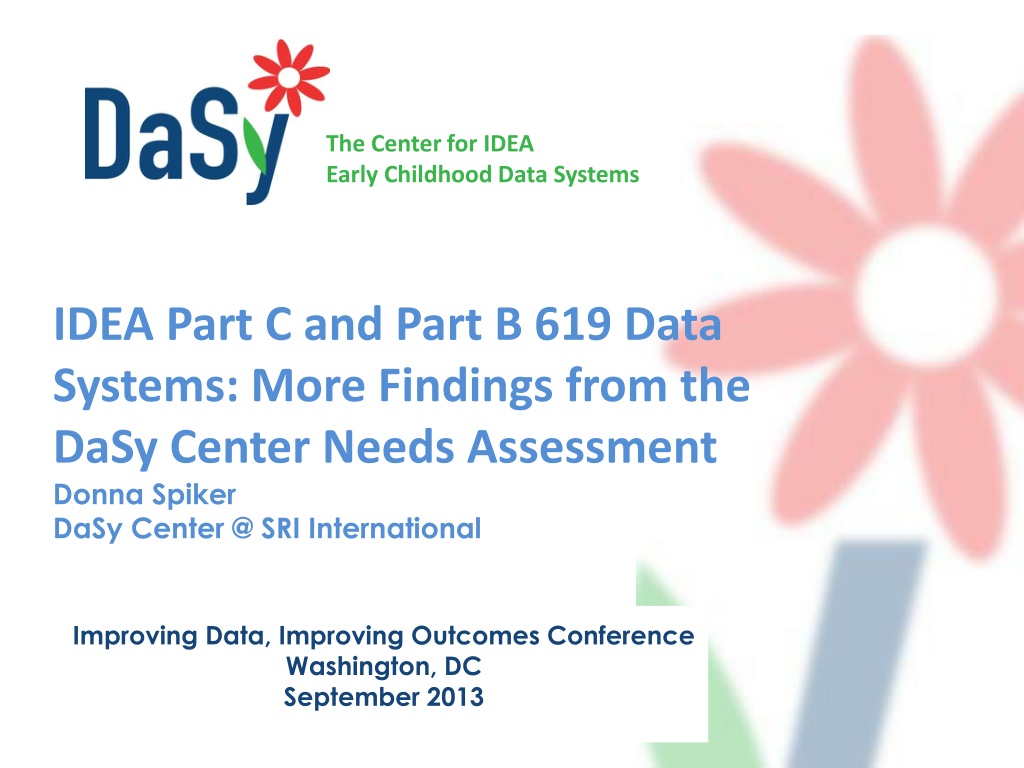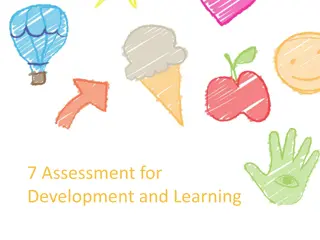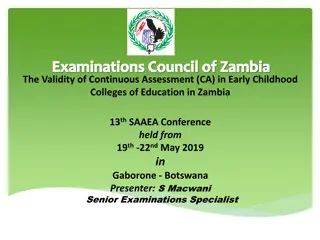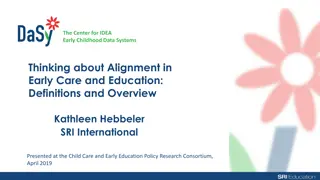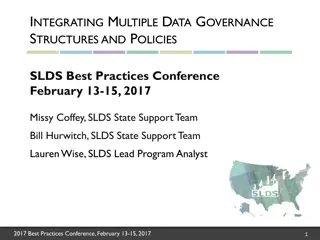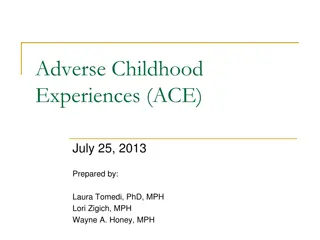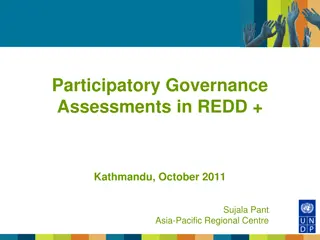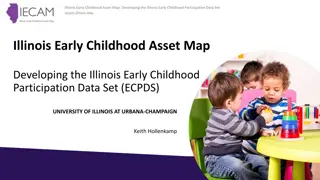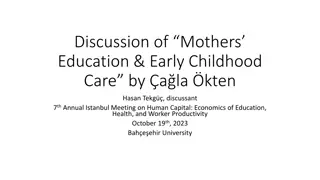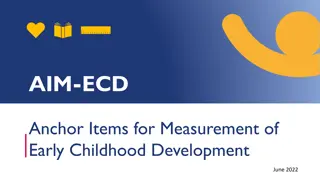Early Childhood Data Systems Governance and Data Quality Assessment
This content highlights the importance of data governance in early childhood data systems, focusing on Part C and Part B 619 data systems. It discusses the findings from the DaSy Center needs assessment, covering topics such as data governance, data quality, and procedures for ensuring accurate and trustworthy data for decision-making. The information reveals gaps in data governance structures across states and emphasizes the significance of maintaining data quality for effective management and decision-making.
Download Presentation

Please find below an Image/Link to download the presentation.
The content on the website is provided AS IS for your information and personal use only. It may not be sold, licensed, or shared on other websites without obtaining consent from the author. Download presentation by click this link. If you encounter any issues during the download, it is possible that the publisher has removed the file from their server.
E N D
Presentation Transcript
The Center for IDEA Early Childhood Data Systems IDEA Part C and Part B 619 Data Systems: More Findings from the DaSy Center Needs Assessment Donna Spiker DaSy Center @ SRI International Improving Data, Improving Outcomes Conference Washington, DC September 2013
What we will cover DaSy Center needs assessment conducted with all states and territories Additional information not covered in plenary session: Data governance Procedures for checking data Data access and use Discuss your reactions to the findings 2
Brief reminder about purposes, methods, respondents . To inform the DaSy Center s work, the Center collected information about the: Current status of Part C and Part B 619 state data systems, Priorities for improvement, and Areas where the states would like TA. Online survey completed by Part C and Part B 619 coordinators, with data managers and other state staff Report focuses on information from 50 states, DC, Puerto Rico Response rate was 94% for C and 96% for 619 3
Data governance: What is it and why is it important? Defined as entities that establish policy and procedures for the overall management of the availability, usability, integrity, quality, and security of the data Having good data governance helps states have confidence that data are accurate and trustworthy and then they can be used for decisionmaking 4
Many states have a data governance body that includes 619, but not one that includes Part C. 69% of states have no data governance body that includes Part C. 72% of states have a data governance body for 619. 35% include Part C 37% include other EC programs 62% include K12 special education 52% include K12 general education 5
Question What do you think about the information on data governance? 6
Checking data quality: Why is it important? To effectively manage data, states need to have processes and procedures to check and verify that the data are accurate, complete, and internally consistent. To ensure and check that data are trustworthy: in their collection entry into the data system consistency with other data in the data system. 7
For both Part C and 619, states use many tools and procedures to check their data. Part C 619 Audits built into data system 98% 92% User manual 83% 90% Verification visits 81% 71% Annual or regular trainings 69% 79% Data dictionary 65% 69% 8
Question What supports are needed for states to check data for its quality? 9
Access to and use of data: Why is it important? The ultimate goals of collecting data and having good state data systems is to have available high- quality information that can be used for different purposes. Access is important because using data to inform decisionmaking at any level (state to local program to teacher or service provider) requires access to information. 10
For both Part C and 619, access to child data is most common for state staff and least common for teachers and service providers. Personnel with access Aggregate data Individual data Part C 619 Part C 619 Part C and 619 coordinators Regional lead or district/LEA School/program Teachers/service provider 96% 77% 94% 83% 77% 73% 67% 75% 58% 64% 62% 67% 42% 44% 56% 52% 11
For both Part C and 619, states use their data for a variety of purposes. Uses for data Part C 619 Checking/reviewing data quality 94% 89% Planning for program improvement 89% 89% Monitoring program improvement 87% 65% Identifying professional development and TA needs 75% 79% Reporting to the public, governor and the legislature 85% 79% 12
Questions What do you think about the more limited access to data at the teacher and service provider levels? Is it surprising that only 77% of the Part B 619 coordinators have access to aggregate-level child data? 13
What is interesting about the information on linkages? These can be linkages: Within Part C and within 619 Across Part C and 619 With K12 education With other early childhood program, social services, health data 14
Only about one-third of states have linked data across Part C and 619. Same system, 15% C and B did not agree, 23% Linked systems, 14% Not linked, 48% 15
There is infrequent use of common identifiers across Part C and 619. Common identifier for C and 619 Child-level 21% Program-level or school-level 12% Workforce-level 6% 16
Linkages with K12 education data are more common for 619 than for Part C. Types of education data in same system or have been linked Part C 619 K12 special education 41% 87% K12 general education 14% 79% 17
Few states have linkages with other EC data for Part C, and almost half have linkages with state preK for 619. Types of other EC data Part C 619 12% 6% 2% 6% 8% 46% 22% 10% 8% 8% State pre-K Head Start Early Head Start Child care Home visiting 18
Linkages with health data are more common for Part C than for 619. Types of health data Part C 619 Medicaid/SCHIP EHDI Vital records Birth defects registry All-payer claims (insurance) WIC/SNAP Hospital Behavioral health 42% 37% 21% 21% 13% 8% 6% 4% 12% 8% 0% 2% 0% 6% 2% 2% 19
Very few states have linked Part C or 619 data to social services data. Types of social services data Part C 21% 12% 619 10% 8% Child welfare Foster care Temporary Assistance for Needy Families (TANF) Homeless services 10% 14% 6% 14% 20
Questions What is interesting about the information on linkages? Which of the linkages are most important to you and why? What are the challenges states face in creating these linkages? 21
What do you think about the limited availability of program-level data in state data systems? Data system Part C 619 Child-level 94% 96% Program-level 29% 40% Workforce: EI providers 65% ---- Workforce: special education teachers ---- 83% Workforce: related service providers ---- 71% Workforce: general education teachers ---- 71% 22
Questions To get copy of report: www.dasycenter.com 23
